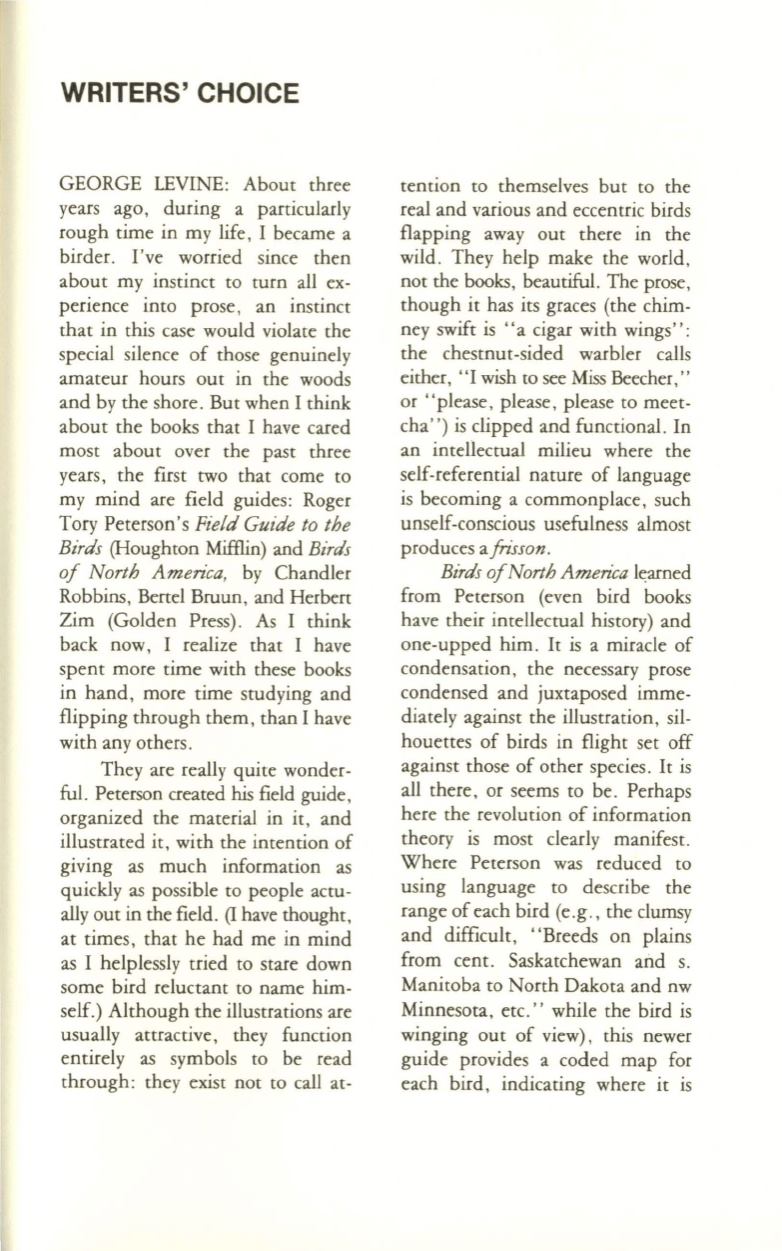
WRITERS ' CHOICE
GEORGE LEVINE: About three
years ago , during a particularly
rough time in my life , I became a
birder. I've worried since then
about my instinct to turn all ex–
perience into prose, an instinct
that in this case would violate the
special silence of those genuinely
amateur hours out in the woods
and by the shore . But when I think
about the books that I have cared
most about over the past three
years, the first two that come to
my mind are field guides: Roger
Tory Peterson's
Field Guide to the
Birds
(Houghton Mifflin) and
Birds
0/
North America,
by Chandler
Robbins, Benel Bruun, and Herben
Zim (Golden Press) . As I think
back now, I realize that I have
spent more time with these books
in hand, more time studying and
flipping through them, than I have
with any others.
They are really quite wonder–
ful. Peterson created
his
field guide,
organized the material in it , and
illustrated it, with the intention of
giving as much information as
quickly as possible to people actu–
ally out in the field.
(I
have thought,
at times , that he had me in mind
as I helplessly tried to stare down
some bird reluctant to name him–
self.) Although the illustrations are
usually attractive, they function
entirely as symbols to be read
through : they exist not to call at-
tention
to
themselves but to the
real and various and eccentric birds
flapping away out there in the
wild . They help make the world ,
not the books, beautiful. The prose,
though it has its graces (the chim–
ney swift is "a cigar with wings" :
the chestnut-sided warbler calls
either, "I wish to see Miss Beecher,"
or "please, please, please to meet–
cha' ') is clipped and functional. In
an intellectual milieu where the
self-referential nature of language
is becoming a commonplace, such
unself-conscious usefulness almost
produces
a/risson .
Birds o/North Amenia
learned
from Peterson (even bird books
have their intellectual history) and
one-upped him. It is a miracle of
condensation, the necessary prose
condensed and juxtaposed imme–
diately against the illustration, sil–
houettes of birds in flight set off
against those of other species . It is
all there, or seems to be. Perhaps
here the revolution of information
theory is most clearly manifest.
Where Peterson was reduced to
using language to describe the
range of each bird (e. g ., the clumsy
and difficult, "Breeds on plains
from cent . Saskatchewan and s.
Manitoba to North Dakota and nw
Minnesota, etc. " while the bird is
winging out of view) , this newer
guide provides a coded map for
each bird , indicating where it is


